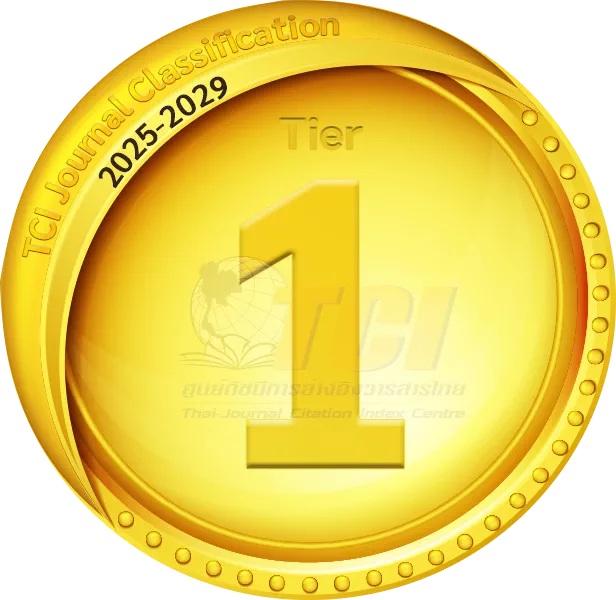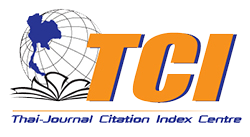การวิเคราะห์การไหลและสมรรถนะการเผาไหม้ของหัวเผาแก๊สชนิดฝักบัวที่ใช้เชื้อเพลิง LPG และ CNG ด้วยการจำลอง CFD
Flow and Combustion Performance Analysis of LPG and CNG Shower-Type Burners Using CFD Modeling
Abstract
ความต้องการพลังงานอย่างยั่งยืนที่เพิ่มขึ้นในอุตสาหกรรมเซรามิกของประเทศไทยส่งผลให้เกิดความจำเป็นในการเพิ่มประสิทธิภาพการทำงานของหัวเผาโดยใช้เชื้อเพลิงที่สะอาดกว่า แม้ว่าแก๊สปิโตรเลียมเหลว (LPG) จะเป็นเชื้อเพลิงที่นิยมใช้อย่างแพร่หลายเนื่องจากค่าความร้อนที่สูงแต่แก๊สธรรมชาติอัด (CNG) ให้ข้อดีในด้านการปล่อยมลพิษที่ต่ำกว่าและต้นทุนที่ลดลง งานวิจัยนี้ศึกษาลักษณะการเผาไหม้และการไหลของหัวเผาเซรามิกชนิดฝักบัวที่ใช้เชื้อเพลิง LPG และ CNG โดยใช้การจำลองพลศาสตร์ของไหลเชิงคำนวณ (CFD) ควบคู่กับการทดลองจริงเพื่อเพิ่มสมรรถนะของหัวเผาการจำลอง CFD ดำเนินการในสองขั้นตอน ได้แก่ การทดสอบแบบเย็นเพื่อวิเคราะห์การผสมเชื้อเพลิงกับอากาศ และการทดสอบแบบร้อนเพื่อศึกษาพฤติกรรมการเผาไหม้ โดยใช้โปรแกรม FLUENT 2021 R2 ร่วมกับโครงข่าย Tetrahedro และแบบจำลองความปั่นป่วน RNG k–ε การทดลองยืนยันผลดำเนินการที่ความดันเชื้อเพลิง 4 ปอนด์ต่อตารางนิ้ว โดยใช้เทอร์โมคัปเปิลชนิด เค (Thermocouple K-type) สำหรับวัดอุณหภูมิ ผลการทดลองสอดคล้องกับการจำลองโดยมีความคลาดเคลื่อนเฉลี่ยของความเร็ว 6.52% และอุณหภูมิ 5.30% การเผาไหม้ของ LPG ให้ค่าอุณหภูมิสูงสุดมากกว่า 1,375.61 เคลวิน เมื่อเทียบกับCNG 1,332.83 เคลวิน ขณะที่ CNG แสดงความเร็วการไหลสูงกว่าจากความหนาแน่นที่ต่ำกว่า LPG ยังให้ความสม่ำเสมอของอุณหภูมิและความเข้มของการเผาไหม้ที่ดีกว่า ซึ่งเป็นสิ่งสำคัญต่อกระบวนการเผาเซรามิกอย่างคงที่ งานวิจัยนี้เน้นย้ำถึงความสำคัญของการออกแบบหัวเผาอย่างเหมาะสมและการประยุกต์ใช้ CFD เพื่อส่งเสริมการใช้เชื้อเพลิงสะอาดเพิ่มประสิทธิภาพพลังงานและความยั่งยืนด้านสิ่งแวดล้อมในอุตสาหกรรมเซรามิกขนาดเล็กของประเทศไทย
The increasing demand for sustainable energy in Thailand’s ceramic industry has led to the need for improving burner performance using cleaner fuels. Although Liquefied Petroleum Gas (LPG) is commonly used due to its high calorific value, Compressed Natural Gas (CNG) is considered more environmentally friendly and cost-effective. In this study, the combustion and flow characteristics of a shower-type ceramic burner using LPG and CNG were analyzed through Computational Fluid Dynamics (CFD) simulations and validated by experiments. The CFD work was divided into two parts: a cold-flow analysis to examine fuel–air mixing, and a hot-flow simulation to study combustion behavior. ANSYS Fluent 2021 R2 was used with a tetrahedral mesh and the RNG k–ε turbulence model. Experiments were carried out at 4 psi fuel pressure, and a K-type thermocouple was used to measure flame temperature. The simulated results agreed well with the experimental data, showing average deviations of 6.52% in velocity and 5.30% in temperature. LPG produced a slightly higher peak temperature (1,375.61 K) than CNG (1,332.83 K), while CNG showed higher flow velocity due to its lower density. Moreover, LPG provided a more uniform temperature distribution, which is beneficial for consistent ceramic firing. These results suggest that although CNG is cleaner, LPG offers better combustion characteristics under the current burner design. The findings highlight the potential for improving burner design through CFD modeling to support fuel switching in small-scale ceramic industries in Thailand.
Keywords
[1] Energy Policy and Planning Office (EPPO). General Energy Information. [Online]. Available: https://www.eppo.go.th/epposite/templates/ eppo_v15_mixed/eppo_oil_gen.php.
[2] W. Puttapoun, J. Moran, P. Aggarangsi, and A. Bunkham, “Powering shuttle kilns with compressed biomethane gas for the Thai ceramic industry,” Energy for Sustainable Development, vol. 28, pp. 95–101, 2015.
[3] Y. Juntarawijit and C. Juntarawijit, “Cooking smoke exposure and respiratory symptoms among those responsible for household cooking: A study in Phitsanulok, Thailand,” Heliyon, vol. 5, no. 6, pp. e01706, 2019.
[4] M. Wae-hayee, K. Yeranee, W. Suksuwan, and C. Nuntadusit, “Effect of burner-to-plate distance on heat transfer rate in a domestic stove using LPG,” Case Studies in Thermal Engineering, vol. 28, pp. 101418, 2021
[5] N. Sritrakul and T. Hudakorn, “The economic value and satisfaction of substituting LPG in households by a biogas network: A case study of Bo Rae subdistrict in Chai Nat province Thailand,” Energy Reports, vol. 6, pp. 565–571, 2020.
[6] K. Chuenwong, S. Chiarakorn, and B. Sajjakulnukit, “Specific energy consumption and carbon intensity of ceramic tablewares: Small Enterprises (SEs) in Thailand,” Journal of Cleaner Production, vol. 147, pp. 395–405, 2017.
[7] M. S. A. Momin, M. Dutta, M. G. Kader, and S. M. Iftakher, “Study of LPG (LiquefiedPetroleum Gas) and CNG (Compressed Natural Gas) vehicles and its future aspects,” in Proceedings of the International Conference on Mechanical, Industrial and Energy Engineering (ICMIEE), Khulna, Bangladesh, 2016.
[8] N. I. Masuk, K. Mostakim, and S. D. Kanka, “Performance and emission characteristic analysis of a gasoline engine utilizing different types of alternative fuels: A comprehensive review,” Energy & Fuels, vol. 35, no. 6, pp. 4644– 4669, 2021.
[9] M. I. Khan, T. Yasmin, and A. Shakoor, “Technical overview of compressed natural gas (CNG) as a transportation fuel,” Renewable and Sustainable Energy Reviews, vol. 51, pp. 785–797, 2015.
[10] S. Jugjai and S. Sanitjai, “Parametric studies of thermal efficiency in a Proposed Porous Radiant Recirculated Burner (PRRB): A design concept for the future burner,” International Energy Journal, vol. 18, no. 2, 1996.
[11] P. Aroonjarattham, “The parametric studied of high pressure gas burner affect thermal efficiency,” Engineering Journal, vol. 20, no. 3, pp. 33–48, 2016.
[12] P. Boggavarapu, B. Ray, and R. V. Ravikrishna, “Thermal efficiency of LPG and PNG-fired burners: Experimental and numerical studies,” Fuel, vol. 116, pp. 709–715, 2014.
[13] F. J. Cadavid, Y. Cadavid, A. A. Amell, A. E. Arrieta, and J. D. Echavarría, “Numerical and experimental methodology to measure the thermal efficiency of pots on electrical stoves,” Energy, 2014.
[14] W. Li, M. Al-Khishali, and A. Kewlani, “Pollutant emission validation of a heavy-duty gas turbine burner: A 3D CFD study,” International Journal of Thermal Sciences, vol. 191, pp. 107990, 2023.
[15] H. Liu, Z. Wang, and J. Zhao, “A review of employed flame stabilization techniques in development of micro/mesoscale combustion,” Renewable and Sustainable Energy Reviews, vol. 158, pp. 112111, 2022.
[16] A. Salehi, M. Mahmoudi, and M. Saffar-Avval, “A Bayesian optimization framework for the control of combustion stability in a bluff-body combustor,” Energy, vol. 236, pp. 121413, 2021.
[17] M. Shehata, I. A. Ibrahim, and H. M. Gad, “Combustion characteristics of natural gas/air flat premixed laminar flames in a developed matrix burner,” Scientific African, vol. 20, pp. e01659, 2023.
[18] D. S. Yadav and B. Paul, “Conversion of the domestic LPG cook stove to use biogas fuel: An experimental approach,” Transactions of the Indian National Academy of Engineering, vol. 7, pp. 1213–1222, 2022.
[19] F. J. Rojas, F. Jiménez, and J. Soto, “Design and experimental analysis of an improved burner with natural gas,” Energy Efficiency, vol. 14, no. 43, pp. 1–13, 2021.
[20] Z. F. A. Gani, “Experimental investigation on lift-off, blowout, and drop-back in partially premixed LPG open flames in tubular burner,” Thermal Science, vol. 26, no. 6A, pp. 4607– 4615, 2022.
[21] R. A. Pradana, T. Prabowo, and A. Saifudin, “Pengaruh variasi lubang udara terhadapefisiensi kompor gas LPG,” J-Proteksion, vol. 10, no. 2, pp. 23–28, 2020.
[22] H. O. Gómez, M. C. Calleja, L. A. Fernández, A. Kiedrzynska, and R. Lewtak, “Application of the CFD simulation to the evaluation of natural gas replacement by syngas in burners of the ceramic sector,” Energy, vol. 185, pp. 15–27, 2019.
[23] M. Wichangarm, A. Matthujak, T. Sriveerakul, S. Sucharitpwatskul, and S. Phongthanapanich, “Investigation on thermal efficiency of LPG cooking burner using computational fluid dynamics,” Energy, vol. 203, pp. 117849, 2020
[24] A. Matthujak, M. Wichangarm, T. Sriveerakul, S. Sucharitpwatskul, and S. Phongthanapanich, “Numerical and experimental study for a modified LPG cooking burner,” Journal of King Saud University – Science, vol. 35, pp. 102752, 2023.
DOI: 10.14416/j.kmutnb.2025.10.001
ISSN: 2985-2145





